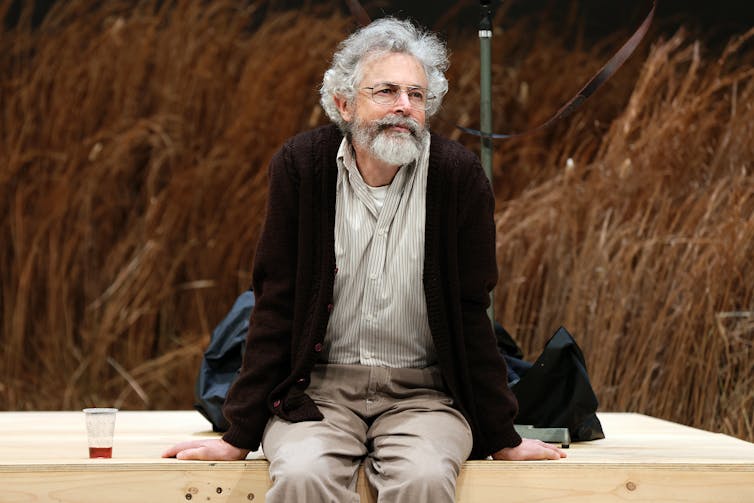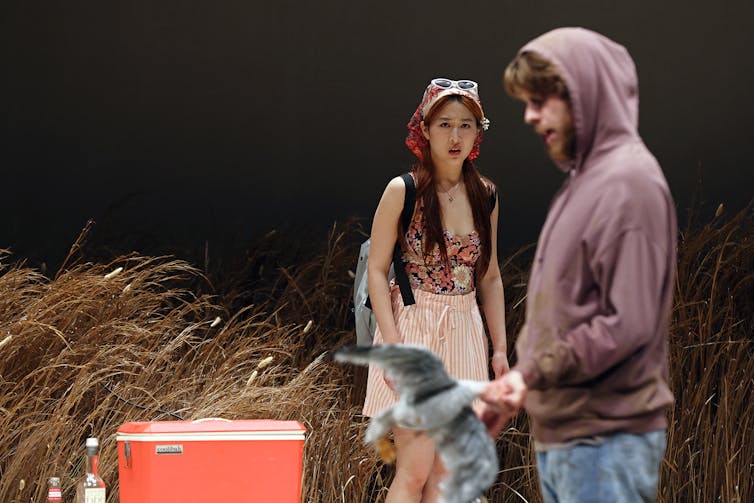Sunday, 13 April 2025
Post-apocalyptic 'The Last of Us' more timely than ever, say stars
Friday, 21 February 2025
Shakira kicks off first world tour in seven years


Monday, 10 February 2025
How to watch a scary movie with your child
 Carol Newall, Macquarie University
Carol Newall, Macquarie University
On Halloween, the cinemas and TV channels are filled with horror movies. But what should you do if you have a young child who wants to watch too?
Many of us have a childhood memory of a movie that gave us nightmares and took us to a new level of fear. Maybe this happened by accident. Or maybe it happened because an adult guardian didn’t choose the right movie for your age.
For me it was The Exorcist. It was also the movie that frightened my mum when she was a youngster. She had warned me not to watch it. But I did. I then slept outside my parents’ room for months for fear of demonic possession.
Parents often ask about the right age for “scary” movies. A useful resource is The Australian Council of Children and the Media, which provides colour-coded age guides for movies rated by child development professionals.
Let’s suppose, though, that you have made the decision to view a scary movie with your child. What are some good rules of thumb in managing this milestone in your child’s life?
Watch with a parent or a friend
Research into indirect experiences can help us understand what happens when a child watches a scary movie. Indirect fear experiences can involve watching someone else look afraid or hurt in a situation or verbal threats (such as “the bogeyman with sharp teeth will come at midnight for children and eat them”).
Children depend very much on indirect experiences for information about danger in the world. Scary movies are the perfect example of these experiences. Fortunately, research also shows that indirectly acquired fears can be reduced by two very powerful sources of information: parents and peers.
In one of our recent studies, we showed that when we paired happy adult faces with a scary situation, children showed greater fear reduction than if they experienced that situation on their own. This suggests that by modelling calm and unfazed behaviour, or potentially even expressing enjoyment about being scared during a movie (notice how people burst into laughter after a jump scare at theatres?), parents may help children be less fearful.
There is also some evidence that discussions with friends can help reduce fear. That said, it’s important to remember that children tend to become more similar to each other in threat evaluation after discussing a scary or ambiguous event with a close friend. So it might be helpful to discuss a scary movie with a good friend who enjoys such movies and can help the child discuss their worries in a positive manner.
Get the facts
How a parent discusses the movie with their child is also important. Children do not have enough experience to understand the statistical probability of dangerous events occurring in the world depicted on screen. For example, after watching Jaws, a child might assume that shark attacks are frequent and occur on every beach.
Children need help to contextualise the things they see in movies. One way of discussing shark fears after viewing Jaws might be to help your child investigate the statistics around shark attacks (the risk of being attacked is around 1 in 3.7 million) and to acquire facts about shark behaviours (such as that they generally do not hunt humans).
These techniques are the basis of cognitive restructuring, which encourages fact-finding rather than catastrophic thoughts to inform our fears. It is also an evidence-based technique for managing excessive anxiety in children and adults.
Exposure therapy
If your child is distressed by a movie, a natural reaction is to prevent them watching it again. I had this unfortunate experience when my seven-year-old daughter accidentally viewed Miss Peregrine’s Home for Peculiar Children, which featured a monster with knives for limbs who ate children’s eyeballs for recreation.
My first instinct was to prevent my daughter watching the movie again. However, one of the most effective ways of reducing excessive and unrealistic fear is to confront it again and again until that fear diminishes into boredom. This is called exposure therapy.
To that end, we subjected her and ourselves to the same movie repeatedly while modelling calm and some hilarity - until she was bored. We muted the sound and did silly voice-overs and fart noises for the monster. We drew pictures of him with a moustache and in a pair of undies. Thankfully, she no longer identifies this movie as one that traumatised her.
This strategy is difficult to execute because it requires tolerating your child’s distress. In fact, it is a technique that is the least used by mental health professionals because of this.
However, when done well and with adequate support (you may need an experienced psychologist if you are not confident), it is one of the most effective techniques for reducing fear following a scary event like an accidental horror movie.
Fear is normal
Did I ever overcome my fear of The Exorcist? It took my mother checking my bed, laughing with me about the movie, and re-affirming that being scared is okay and normal for me to do so (well done mum!)
Fear is a normal and adaptive human response. Some people, including children, love being scared. There is evidence that volunteering to be scared can lead to a heightened sense of accomplishment for some of us, because it provides us with a cognitive break from our daily stress and worries.
Hopefully, you can help ensure that your child’s first scary movie experience is a memorable, enjoyable one.![]()
Carol Newall, Senior Lecturer in Early Childhood, Macquarie University
This article is republished from The Conversation under a Creative Commons license. Read the original article.
Friday, 3 January 2025
Australia has a remarkable history of outdoor cinema. Here’s why Netflix will never beat it
 Dendy Powerhouse Outdoor Cinema
Ruari Elkington, Queensland University of Technology
Dendy Powerhouse Outdoor Cinema
Ruari Elkington, Queensland University of TechnologyIn December 1916, as war raged in Europe, an entrepreneurial pearl diver took a chance on some bleeding-edge technology and installed an outdoor cinema in one of the country’s most isolated towns – Broome, Western Australia.
Ted Hunter didn’t know much about cinemas. Not many people did at the turn of the 20th century. But that didn’t stop him beginning what has become a long history of outdoor cinema exhibition in Australia.
Sun Pictures in Broome opened with Jack Hulcup’s 1913 silent film Kissing Cup, in which a “squire’s jockey” escapes kidnappers and gallops across the Isle of Wight in time to win the race. Huzzah.
More than a century later, Sun Pictures still stands – the world’s oldest operating open-air cinema.
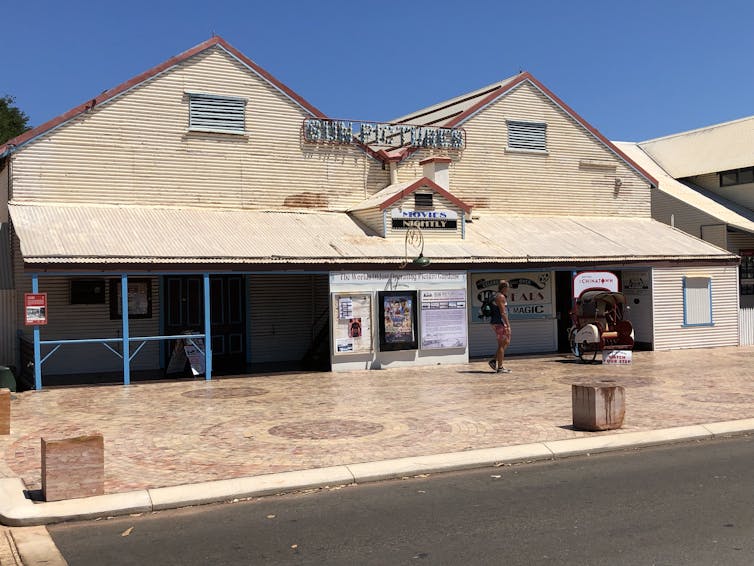 Sun Pictures was often subject to tidal flooding prior to a levee built in 1974. Locals have shared stories of watching films with fish swimming around their feet. Wikimedia, CC BY-SA
Sun Pictures was often subject to tidal flooding prior to a levee built in 1974. Locals have shared stories of watching films with fish swimming around their feet. Wikimedia, CC BY-SAWhile the Guinness World Record is a nice-to-have, Sun Pictures’ survival has been ensured not by the latest Hollywood blockbuster, but by what the cinema offers locals and visitors each night: a moviegoing experience that is at once unique and familiar.
Segregation at the movies
Before opening Sun Pictures, Hunter made his money as a master pearler. Pearl shells, which were turned into mother-of-pearl buttons, transformed the economic life of Broome in the late 1800s. Despite being so isolated, the pearling industry brought great riches to the town, while also entrenching workers along racial lines.
Racial segregation was firmly present in Broome’s “picture garden” for the first half of the 20th century. White Australians and their kids were seated in the middle, with Chinese and Japanese patrons behind them. Malays, Filipinos and First Nations people entered separately and were seated at the sides, or remained standing.
Aboriginal rights activist Charles Perkins would later directly challenge the segregation of Australian cinemas in his 1965 “Freedom Ride” throughout rural New South Wales.
Outdoors, from the comfort of your car
My colleague Tess Van Hemert and I have spent the past three years researching the cultures and practices of cinemagoing and how cinema sites shape this experience.
Outdoor cinemas – whether they be the picture gardens of Broome or the Yatala Drive-In – function as special sites of culture, connection and community.
During COVID lockdowns, social distancing measures particularly invigorated drive-in cinema attendance. But even after lockdowns ended, David Kilderry, the long-time operator of Melbourne’s Lunar Drive-in, remains clear on the appeal:
You could open up the car or even sit outside it and if cool, hop back inside and snuggle up in private. […] You can talk about the film as it runs. Kids can ask questions and parents can explain. Patrons can use phones during the film without interrupting others, and babies and infants won’t annoy other customers […] The drive-in has always been more than just a movie experience. It’s where the two icons of the 20th century come together: the motion picture and the automobile.
While the Lunar was shuttered in 2023, Kilderry said this decision was less about the 400,000 annual patrons and more about the land tax implications of keeping a site of that size viable.
But it’s not all doom and gloom for drive-ins. Kilderry notes many operators now own their land, rather than trying to constantly negotiate leases.
There are currently about 12 drive-ins running regularly across Australia, with a few more opening for the occasional screening. New drive-in developments are also planned for Perth, pending local consultations.
Connecting with others and the environement
Beyond drive-ins, Sun Pictures is in good company with a range of locations around the world that actively celebrate outdoor cinema.
During the European summer, open-air cinemas are popular in countries such as Germany and Italy. In Bologna, three large piazzas – Piazza Maggiore, Arena Puccini and Piazzetta Pasolini – are set up as cinemas for the annual Cinema Ritrovato festival.
Closer to home, the University of Western Australia’s Somerville Auditorium, framed by a “tree cathedral” of mature Norfolk pines, has long been a place of unique outdoor cinema experiences.
Perth Festival film programmer Tom Vincent understands the distinct pleasures of outdoor cinemagoing:
The m ost memorable cinemagoing anywhere will always engage the audience’s sense of place, usually through architecture and experience design. […] It includes a natural sensory mix that includes river breezes, ambient sounds and wildlife, alongside a sense of grandeur and good programming. Good outdoor cinema says ‘look, we are here, engage all your senses’.
But while seasonal outdoor cinemas such as the Moonlight Cinemas continue to operate around Australia – alongside local council park screenings – openings of new permanent outdoor cinemas are rare.
Phoebe Condon, manager of the new permanent Dendy Powerhouse Outdoor Cinema in Brisbane, explained how the site positions itself as a high-value leisure experience:
It’s more than just a night at the movies – it’s a destination […] What truly sets us apart from other outdoor cinemas is our focus on creating an elevated, year-round experience.
This framing of outdoor cinema as an “elevated experience” is vital. While the cost of cinemagoing has come up as a key consideration in our research (especially in the current economic context) the industry is quick to remind consumers it remains affordable compared with other out-of-home arts and leisure experiences such as live sports, music, comedy and theatre.
Despite legitimate cost-of-living concerns, census data continues to show cinemagoing as the nation’s most popular cultural activity.
Why Neflix can’t replace cinemas
Our research on Australian cinemagoing supports broader arguments for a more holistic understanding of cinema’s value in society. Cinemagoing shouldn’t be compared to your Netflix subscription, but to other leisure activities people get up and leave the house for.
As the International Union of Cinemas notes, “films reflect national culture or subcultures and the wider world to the audience; they frame moral and political discussions; and they entertain and educate”.
We also know cinemagoing has never stood still. Ever since Hunter took a chance on outdoor cinema in 1916, these spaces have evolved constantly to respond to new challenges and shifting appetites.
But one aspect remains the same: whether sat under the stars, or parked in a lot, Australians continue to see the value in leaving their homes to connect and share in new stories on the big screen.![]()
Ruari Elkington, Senior Lecturer in Creative Industries & Chief Investigator at QUT Digital Media Research Centre (DMRC), Queensland University of Technology
This article is republished from The Conversation under a Creative Commons license. Read the original article.
Monday, 22 July 2024
Rakul Preet shares her mantra of energy, good looks: 'Keep my karma clean, focus on my job'

Wednesday, 3 January 2024
Chekhov called The Seagull ‘a comedy’. The Sydney Theatre Company seems to forget it was a tragedy, too
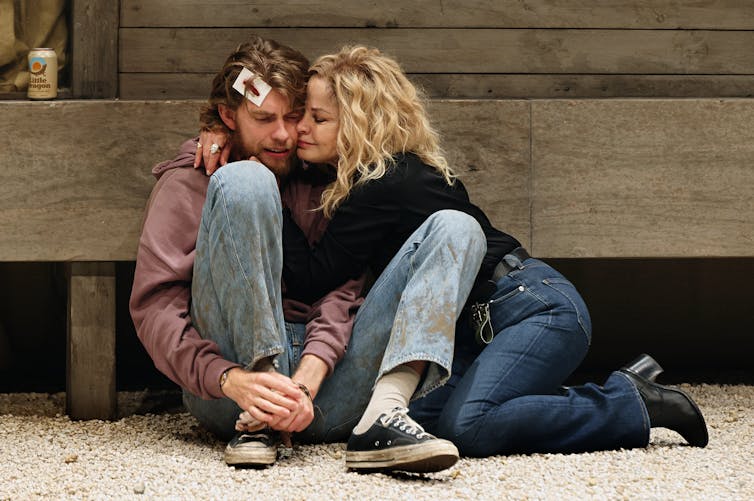 Prudence Upton/Sydney Theatre Company Alexander Howard, University of SydneyWhat is comedy?
Prudence Upton/Sydney Theatre Company Alexander Howard, University of SydneyWhat is comedy?
This is the question I kept coming back to while watching Andrew Upton’s adaptation of Anton Chekhov’s The Seagull, which opened to warm applause – and a touch of controversy – at the Sydney Theatre Company on Saturday.
Theatre scholar Eric Weitz notes that comedy is a genre “with characteristic features”.
Laughter, humour, distraction. These are some of the terms associated with comedy.
Comedy is also restless. As Weitz acknowledges, comedy “embraces a range of subgenres” and often “cross-pollinates with other genres to form the likes of tragicomedy”.
These cross-pollinations can often confuse.
Consider the very first performance of The Seagull, subtitled “a comedy in four acts”.
The notorious performance at the Alexandrinsky Theatre in Saint Petersburg on October 17 1896 was an unmitigated failure. The audience jeered; the reviews were scathing.
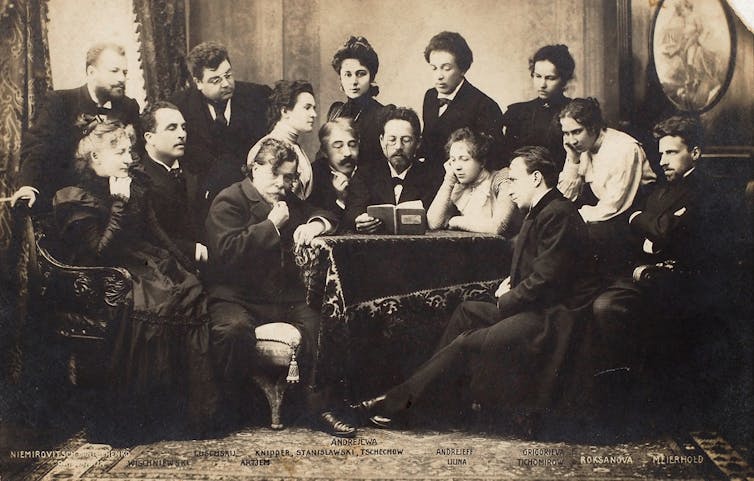 Chekhov reads The Seagull with the Moscow Art Theatre company, 1898. Wikimedia Commons
Chekhov reads The Seagull with the Moscow Art Theatre company, 1898. Wikimedia CommonsIn a letter sent to the publisher Aleksey Suvorin the very next day, a wounded Chekhov declared he would never again “write plays or have them acted”.
The reason why the premiere went so badly has to do with audience expectations. As essayist Janet Malcolm explains, there were special circumstances on the night in question.
The performance was part of a benefit event for E. I. Levkeeva, a popular Russian comic actress, “and so the audience was largely made up of Levkeeva fans, who expected hilarity and, to their disbelief and growing outrage, got Symbolism.”
Primed for broad comedy, the audience didn’t know what to do with Chehkov’s groundbreaking spin on the genre, which broke with established realist modes and placed emphasis on metaphorical imagery and allegorical tropes.
While the play, which speaks to the themes of art and desire, has many funny moments, it simultaneously foregrounds discussions of mortality and depictions of madness. And it ends with a suicide.
Moreover, Chekhov’s play is one where, as the academic James Loehlin writes
the old win out over the young, where hope and the impulse for change are crushed, in part through their own fragility and lack of conviction, but in part by the proficient ruthlessness of the seasoned old campaigners, their elders.
I mention this because the serious and subtle aspects of The Seagull – many of which continue to resonate today – can get lost in modern takes on Chekhov’s play.
This is true of the Sydney Theatre Company’s production. Adapted by Upton and directed by Imara Savage, this version showcases the sound work of Max Lyandvert and features a meta-theatrical set designed by David Fleischer.
The adaptation is set in contemporary rural Australia and uses anglicised character names. Upton and Savage stick with Chekhov’s formal structure, but privilege the comedic at the expense of pretty much everything else when it comes to delivery.
This has ramifications for how the adaptation pans out.
Success beckons, tragedy befalls
The play comprises four acts and centres on four characters who mirror each other.
Constantine (Harry Greenwood) and Boris (Toby Schmitz) are writers. Boris is famous. Constantine – a college dropout who fancies his chances as an avant-gardist – is most definitely not.
Irina (Sigrid Thornton) and Nina (Mabel Li) are actors. Irina, who is Constantine’s mother and Boris’s lover, is a renowned stage star. The ingénue Nina, who is dating Constantine, desperately wants to make it.
Success beckons, but tragedy eventually befalls Nina – who leaves Constantine for Boris – in the two year gap between the play’s third and fourth acts.
These characters are joined by several others, including Irina’s ailing landowner brother Peter (Sean O'Shea), and a depressive young goth, Masha (Megan Wilding). With the exception of one, every character in the play is morose.
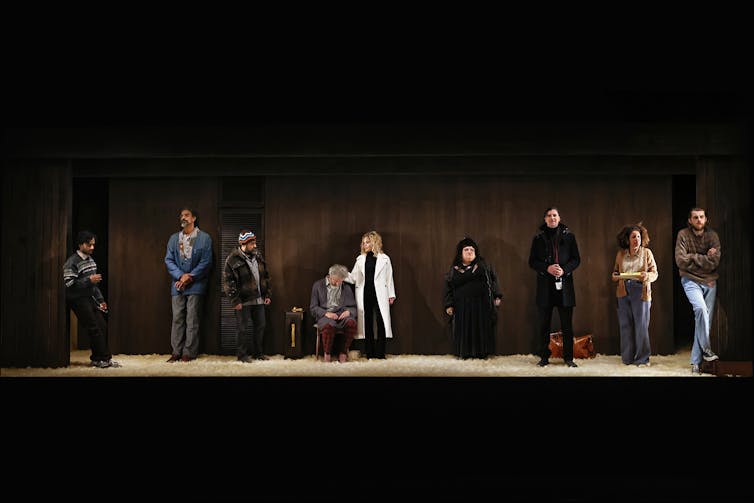 With the exception of one, every character in the play is morose. Prudence Upton/Sydney Theatre Company
With the exception of one, every character in the play is morose. Prudence Upton/Sydney Theatre CompanyThe first act is structured around an abortive performance of an experimental theatre piece Constantine has worked up. Nina and Boris grow close in the second, while Irina holds court. At the start of the third act, it is revealed Constantine has tried to take his own life. Boris threatens to leave Irina for Nina. Hilarity ensues as Irina tries to win him back.
The atmosphere that the Sydney Theatre Company creative team establishes in each of these acts is lighthearted and largely humorous. Indeed, there are some moments, as when a gravely ill Peter convulses on the ground in the third act, when the onstage action almost tips over into outright farce.
As Chekhov himself insisted, different types of comedy – including farce – had roles to play in The Seagull. However, the overarching tonal emphasis in this adaptation causes problems in the play’s last act, which is set indoors during the Australian winter.
Peter, not long for the world, spends his time talking about how he regrets his entire life. The other characters fob him off. Constantine has made headway as a writer, but is deeply unhappy. He pines after Nina, who dropped off the radar somewhere between acts.
Time passes, and trivialities exchanged. A bedraggled Nina reappears. The story she tells is one of sorrow and woe. A genuinely moving moment, the speech is delivered with real affective intensity – undoubtedly the high point of the production.
However, the tonal chasm between the final act and the preceding three is simply too great.
In keeping with Chehkov’s original, comedy ultimately gives way to tragedy, but something seems to have been lost along the way.
The Seagull is at the Sydney Theatre Company until December 16.
If this article has raised issues for you, or if you’re concerned about someone you know, call Lifeline on 13 11 14.![]()
Alexander Howard, Senior Lecturer, Discipline of English, University of Sydney
This article is republished from The Conversation under a Creative Commons license. Read the original article.
Monday, 11 September 2023
Past Lives: a luxurious and lingering portrayal of lost love and identity in the Korean diaspora


Friday, 21 July 2023
Five Senses Theatre's Vital Acting Classes in Andheri and Acting School in Mumbai

Tuesday, 14 June 2016
Don't panic! Carry a towel for your safety
- A still from the movie The Hitchhiker's Guide To The Galaxy in which two prominent characters (right) of the novel can be seen carrying a towel — the most massively useful thing an interstellar hitchhiker can have.
- When the Galactic Hyperspace Planning Council was all set to demolish Earth to build a hyperspatial express, Arthur Dent was busy hyperventilating. Just earlier in the day, he was lying in front of a big yellow bulldozer in a vain bid to protect his house from being demolished to build a bypass. It was the town council’s idea to come up with the said structure. Ford Prefect, on the other hand, was succeeding in maintaining a semblance of calm as all this was transpiring.
- Prefect was from Betelgeuse. And he had his towel with him. “The towel”,) The Hitchhiker’s Guide to the Galaxy, says, “is about the most massively useful thing an interstellar hitchhiker can have.” It goes on to expound that other than wrapping it around yourself for warmth, you can use the towel to wave as a distress signal when, for instance, you are trying to escape from the Earth in a hurry.
- May 25 is celebrated the world over as Towel Day. This is the day when froods carry with them their towel for all the universe to see, and proclaim categorically what amazingly put together people they are. These are fans of Douglas Adams and his enormously intelligent and supremely witty oeuvre. Ask them what is the secret of life, the universe and everything, and they’ll unabashedly answer: 42. I know, because I do the same.
- Douglas Noel Adams was born on March 11, 1952, in Cambridge, UK. He famously joked that he was the first DNA to come out of Cambridge, referring to Watson and Crick’s discovery, and subsequent anno-uncement of the structure of deoxyribonucleic acid (DNA) in 1953.
- Douglas Adams was tall. Even as a young boy atte-nding Brentwood School in Essex, he was nearly six feet tall. He often remarked that on class trips, his tea-chers wouldn’t say, “Meet under the clock tower,” or “Meet under the war mem-orial,” but, “Meet under Adams.”
- In 1971, an 18-year-old Douglas Adams was lying drunk in the fields of Innsbruck, Austria. He was travelling through Europe with a stolen copy of The Hitchhikers Guide to Europe. “I hadn’t read Europe in Five Dollars a Day,” he confessed years later, “I wasn’t in that financial league.” Enervated, looking up at the night sky, he thought someone ought to write The Hitchhiker’s Guide to the Galaxy and then promptly forgot about it.
- Until six years later. He was then at Cambridge, ostensibly studying for a degree in English, but mainly trying rather unsuccessfully to get a foot into Footlights. He missed a lot of deadlines on assignments, a trait which would be his for the rest of his life. “I love deadlines. I love the whooshing noise they make as they go by,” he once remarked.
- Slowly and unsteadily, after a string of unsuccessful jobs (chicken shed cleaner, lift operator to a wealthy Saudi businessman), his writing career took off in the same fashion: slowly and unsteadily. The drunken thought that he first had while lying stargazing in Innsbruck revisited him, and he wrote The Hitchhiker’s Guide to the Galaxy as a BBC Radio Series. People loved it, and gradually enough it was adapted into various formats, including stage shows, novels, TV series, a computer game, and a feature film.
- Not just a brilliant mind, Douglas Adams had a compassionate heart as well. He was a gallant crusader for Save The Rhino International, and once climbed Mt. Kilimanjaro in a rhino suit (while missing some deadlines) to raise awareness for the cause. The aye-aye lemur, the Chinese dolphin baiji, and the kakapo from New Zealand are the other animals that Douglas Adams travelled far to see and wrote about in The Last Chance to See.
- A larger-than-life man, Douglas Adams died of a heart attack in 2001. He was 49. Two weeks after his death, on May 25, 2001, Towel Day was organised for the first time. Descri-bing the choice of the day to pay tribute to the much-loved writer, towelday.org states: As the universe that Douglas Adams created was full of absurdity and randomness, it may be a fitting choice after all. Every year since then, Douglas Adams-o-philes openly carry their towels with them to work, to libraries, and just about anywhere. Notably, last year, astronaut Samantha Cristoforetti read aloud a section from The Hitchhik-er’s Guide to the Galaxy from the International Sp-ace Station, and tweeted an image of her carrying her towel and wearing a T-shi-rt with the slogan, “Don’t Panic and carry a towel.”
- Towels are a good thing. Roosta knows. He’s accompanying Zaphod Beeblebrox to Frogstar — the most totally evil place in the Universe. The yellow stripes on his towel are rich in protein, the green ones have Vitamins B and C, and the pink flowers in it have wheat germ extracts. The brown stains are Bar-B-Q sauce. And the other end of the towel has antidepressants. Needless to say, he spends quite some time in routine towel maintenance.
- So there you have it. The nitty-gritty of Towel Day. Bring out yours, and wave it around. Who knows, you might just hitch a hike on a passing flying saucer. Or at the very least you’ll let the world know what a hoopy person you are. Which in hitchhiking slang translates to: There’s a frood who really knows where his towel is.
- The author teaches chemistry at Women’s Christian College, Chennai. Source: http://www.asianage.com/: The Asian Age
Tuesday, 17 November 2015
The reel deal
Sunday, 8 November 2015
Prem is back!
glossy journey of Sooraj Barjatya's highly anticipated ‘Prem Ratan Dhan Payo’ met with a rough patch. Apparently, the film's Telugu version, which has been titled ‘Prem Leela’, has got into a pothole, as the title is not in-sync with the censor rules for dubbed films down south. A close source from the censor board says, "The title of ‘Prem Ratan Dhan Payo’ in Telugu has been kept as ‘Prem Leela’. The two titles mean completely different things. As per guidelines the title of a dubbed film must convey the same meaning as the original title. If not, then the producers must apply for permission to use a
Sunday, 3 May 2015
Whyfor he’s back?
outing leads to the film’s real villain, Digvijay Patil (Suman Talwar) who repeatedly announces, “I am a brand”. Instantly we know that Gabbar will bajao his band. But only after we are treated to a flashback starring a star and a tragedy that’s so fake that it’s laughable. This is followed by some more tacky fight scenes that involve the same-old slaps, flying kicks, humans smashing into glass windows, tables, chairs, cupboards, and when we finally arrive at the climax we find that this Gabbar doesn't just kill. He also delivers pravachans to the nation's youth who are weaving the future, one post at a time, on Twitter and Facebook. Director Krish and superstar Akshay’s GIB is a hectic, loud film that skids from one episode to another introducing characters — all prefabricated, one-dimensional ones necessary for simulating a vigilante melodrama — and pushing the story to its inevitable end. All vigilante films are devious. They cast us in the role of hapless onlookers as tragedies claim sweet innocents and the only thing left to do is to bay for blood. For our satisfaction, stars have been bludgeoning the corrupt for ages, and saying, take the law in your own hands. Though exploitative and formulaic, many were good films. GIB is a bad film that’s also disturbingly cynical in its plotting. Somewhere in the bombast and bakwas of GIB sits a tiny kernel of truth — about our ironic, sad lives, about Bharat Sarkar that does everything unscrupulous under the aegis of Satyamev Jayate. The film dips into that — making us weep over our own frustrations, anger — and first lets us draw satisfaction from watching the powerful and corrupt quake with fear and die, and then, pandering shamelessly to our mob mentality, goads us to take action without accountability. The worst message possible in these moronic. Sure, somewhere the slaps that are delivered need to be delivered. Sure, some scenes are funny. But GIB says it’s noble to act, not introspect; that if you are angry, you must be innocent. That’s the biggest lie we tell ourselves. And GIBtells it again and again. The doofus played by Shruti Haasan is totally superfluous to the film. She irritates us with nonsensical chitter-chatter about “according to Google… as per Google…” I googled and, well, according to Google, Ms Haasan has had a successful lip and nose job. So that, perhaps, is why she was hanging around pouting — to exhibit her newly-remodelled face. I fear that in a year’s time all Bollywood actresses will look the same, their faces sitting somewhere in the face-card that moves from Aishwarya Rai to Katrina Kaif. That’s Bollywood’s template of beauty. It’s another matter that Aishwarya and Katrina may not look like themselves in a year’s time. Akshay Kumar sometimes uses a stunt in fight scenes and all villains stand around
as if in a game of Statue, waiting for his kicks to arrive. But he has very healthy gums. His dentist would be proud. He still, however, insists on wearing shirts with hoods. His wife should be worried. Source: Article, Gabbar has ‘nothing to do’ with Sholay: While his character is named after the iconic villain from Sholay, Gabbar is Back’s leading man Akshay Kumar says the film has no other connection to the classic Dharmendra-Amitabh Bachchan caper. “We have just two-three dialogues from Sholay, otherwise GIB has nothing to do with Sholay. The film begins with my character writing an anonymous letter to the (police) commissioner, about corruption. I can’t sign my real name, and Sholay happens to be playing in the background, so I sign it as Gabbar,” Akshay told us. About the South film Ramanaa of which GIB is a remake, Akshay says, “Our film is 60 per cent like Ramanaa but we have added a lot of real incidents. I was told not to watch Ramanaa and I prefer it that way. I don’t want to copy any actor.” Source: Article, ‘Gabbar’s not a masala film’: Shruti Haasan, whose film Gabbar is Back releases today, isn’t very happy about it being projected as a masala film. “I don’t know why people call it a masala film. It’s an entertaining film with a message, which is a great balance.” Would that be her favourite genre? “Comedy is a genre I enjoy very much. I come across as serious, but I’m a goofball. I also want to explore action. I trained in it when was young, so maybe I could mix action and music. That'll be great! Maybe perform stunts with an electric guitar,” she says about her filmy fantasy. Shruti shares screen space with two other actresses in the film — Kareena and Chitrangada. How was that? “Kareena’s track is wonderful and it is integral to the story, so I like how it has turned out,” she said. Source: Article. Decoding Gabbar’s look: Akshay Kumar has a new look in Gabbar and the credit goes to his designer Rick Roy, who planned the look. “In terms of the look, we worked on his hair and beard first. I sat with Akshay and Shabina (the producer) on a style that will work for the character. We explained to him what we had in mind. Akshay was super supportive — he grew his hair and beard exactly the way we wanted it. After that, we worked on a colour palette. We didn’t want any costume to stand out randomly, so we used a lot of dull colours and matte fabrics for his shirts. The point was to give him the look of a no-fuss, cool common man.” Rick says he was impressed that despite being a star, Akshay never behaved like one. “I never heard him raise his voice on sets or throw a fit. It’s my second film with him in three years. Even on a stressful shoot day, you meet him in the morning and you feel happy and positive. Akshay doesn’t interfere. He is all about the character. When he sat with Shabina and me for the initial meetings where I explained the look, he saw the references and sketches I made and said, ‘Cool’. That was all. The only things he told me about were technical things like stretch and dupes and his stunt sequences.” Source: Article,
- Movie name: Gabbar Is Back (U/A) 130 min
- Cast: Akshay Kumar, Shruti Haasan, Sunil Grover, Suman Talwar, Jaideep Ahlawat
- Director: Krish
Friday, 1 May 2015
I am not ready for films yet: Karisma Kapoor

Shruti Haasan quits dad Kamal Haasan film
Saturday, 4 April 2015
Movie : 'Woman In Gold' And 'Effie Gray'
Thursday, 2 April 2015
Amitabh Bachchan gets honorary doctorate in Egypt
Emraan Hashmi is a darling: Amyra Dastur
I’m a mother and I look like one: Olivia Wilde

After giving birth to son Otis Alexander 11 months ago, actress Olivia Wilde has embraced her post-baby body. “I am not in perfect shape. In fact, I’m softer than I’ve ever been, including that unfortunate semester in high school when I simultaneously discovered Krispy Kreme and pot,” she said. “The photos of me in this magazine have been generously constructed to show my best angles, and I assure you, good lighting has been warmly embraced. The truth is, I’m a mother, and I look like one,” she added. Wilde, 31, who is engaged to Jason Sudeikis, is unapologetic about the transformation her body has gone through and does not mind sharing very intimate details about the first few weeks after delivery. Source: The Asian Age, Image: flickr.com





